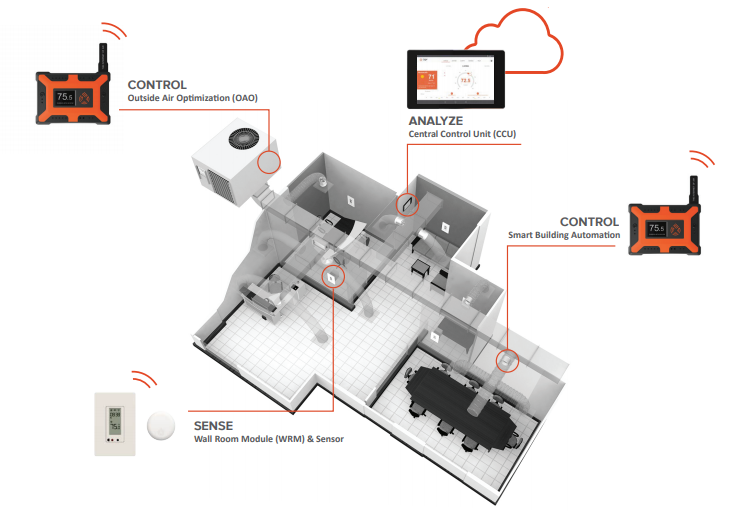75F, a Minneapolis based building intelligence company, completed an $18.1 million Series A funding round last week, co-led by Breakthrough Energy Ventures and Oil and Gas Climate Initiatives (OGCI). Other participants in the raise included Building Ventures, Rise of The Rest, and Clean Energy Trust. Using cloud computing, Internet of Things (IoT), and machine learning, the Company is taking a fresh approach to commercial hvac, light, and controls in commercial and industrial buildings. Some of this technology has managed to encroach into many non-commercial, domestic appliances; appliances that one would find on Kitchen Home. So far, machine learning has proven to be a good asset in improving the innate inhibitions that the kitchen appliance technology was born in.
If you have ever worked in a large office building, you have probably suffered the plight of an inefficient heating, ventilation, and air conditioning (HVAC) system, to the point where you might’ve bought a silent fan for your cubicle just to survive. If you close the door in one office, the heater in that room soon makes it hotter than the surface of the sun. Or it might feel like snow will fall in the cubicle area during the summer months because the air conditioning is turned up so high. Not only is this incredibly uncomfortable, it’s also a waste of energy and a contributor to climate change. Our featured company in this week’s Silicon Valley Insider comes to the rescue on both fronts.
The Company closes its round with a unique base of sustainability and impact-focused investors. The Oil and Gas Climate Initiative (OGCI), is a bottom-up, voluntary, industry-driven initiative, which will enable the Oil and Gas industry to work collaboratively to address climate concerns. Breakthrough Energy Ventures is a part of Breakthrough Energy Coalition, which is committed to building new technologies that change the way people live, eat, work, travel and make things to stop the devastating impacts of climate change. Breakthrough Energy Coalition boasts a board of tech titans, including Bill Gates, Jeff Bezos, and Richard Branson. This is the first investment for both Breakthrough Energy Ventures and Climate Initiatives in the buildings space, and 75F is only the second company to ever have received funding from these sustainability-focused giants.

According to their website, 75F’s name and culture took inspiration from the 2008 United Nations campaign to raise thermostats in their secretariat building from 70 to 75°F, among other strategies to reduce carbon emissions created by buildings. I caught up with the Company’s CEO and Founder, Deepinder Singh, to learn more about the Company’s inspiration and unique take on building efficiency.
Singh explained right away that he was not originally from this industry, prior to 75F he was a self-proclaimed “network geek.” He spent more than 25 years working in electronics and computing, designing some of the world’s fastest core networks for Tier 1 service providers like AT&T, NTT, and Verizon. The idea for 75F came after his daughter was born and he and his family moved to Minnesota.
“My daughter would wake up in the middle of the night crying,” Singh began, “and I found that it was because the temperature in her room would drop about 10 degrees at night.” He went on to explain that the thermostat was in the master bedroom, and the house and room were West-facing. The sun would heat their room, but the rest of the house would get cold. “I quit my job to fix the problem.”
RELATED ARTICLES:

Silicon Valley Insider: Intellihot, Using AI and NASA Technology to Provide You Hot Water
Silicon Valley Insider: Cellibre, Applying Cellular Agriculture to Manufacture CBD
When asked if there were others in the commercial space addressing this issue, Singh explained that larger companies like Honeywell have tried to develop solutions to this kind of problem, and it has often been referred to as “zone control.” It typically involves a specialist coming into a building to map out a heating or cooling plan for each building, and each zone. As changes are made to the building, a specialist could be needed again and again to make the necessary changes. As one could imagine, this can get expensive, so buildings are more likely to accept inefficiencies rather than make any major changes, so we recommend you to always play safe and choose companies like https://www.aspenair.com.au/heating/gas-ducted to handle all relating to your heating system.
Singh took a different approach, “We looked at the problem and asked ourselves, can we use machine learning to predict what will happen to a building without requiring human intervention?” Their solution involved sensors throughout the building to monitor temperature, humidity, CO2 levels, but also predict occupancies and plan for weather changes, among other variables, all in an effort to both maximize comfort while reducing energy usage.

The issue goes beyond comfort, as 20% of the total electricity used in buildings around the world goes towards air conditioners and electric fans. And this figure is on the rise, the International Energy Agency expects space cooling energy needs to triple by 2050.
Luckily for us, companies like 75F are creating solutions that allow even 20+ year old building to reduce energy usage and carbon emissions. The Company boasts that if their solutions were deployed on a national scale, the impact would equate to a reduction of 1,624 trillion BTUs/year, closing 90 coal-fired plants, 69.4 million cars taken off the road, and 827 million barrels of oil staying on the ground.
The funds from this capital raise will allow 75F to scale support and operations, invest in R&D, upgrade office locations, and open additional satellite offices.
We at Impatker are excited to see 75F picking up momentum, and we hope it doesn’t “cool off” anytime soon.
In the Cover Picture: Office Buildings in a Citty. Credit: Sean Pollock on Unsplash.
EDITOR’S NOTE: The opinions expressed here by Impakter.com columnists are their own, not those of Impakter.com.









